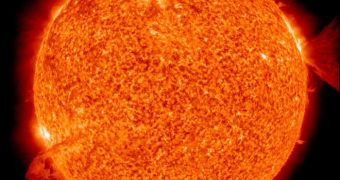Experts at the American space agency have just released a new still image of the Sun, showing the central object of our solar system as it produced two massive solar flares, that put on quite a show.
NASA has been keeping several eyes on the star for a long time, using a number of spacecraft. At this point, the Solar Dynamics Observatory (SDO) is one of the most important of the lot.
The instruments aboard this telescope were the ones that picked up the solar flares before any other spacecraft's. They were recorded yesterday, January 28, and the data suggested a very weird spread pattern.
Usually, solar flares occur relatively near to each other, but these ones appeared almost simultaneously, on opposite sides of the star. These powerful blasts marked the beginning of the 2011 weather season.
For the past few years, the Sun has been acting weird, in the sense that it did not enter the solar maximum stage of its cycle until last years, after more than two years of delay.
According to experts, it is scheduled to reach its peak activity sometimes in 2012-2013. Until then, the strength and frequency of these powerful explosions are bound to increase significantly.
NASA officials who got a chance to peer over the SDO photos said that the flares posed absolutely no danger to either Earth or its vast satellite network, explaining that they were aimed at other locations.
“Neither event was headed towards Earth,” NASA SDO mission scientists said in a statement.
Solar storms can be very dangerous for our planet, because they release billions of tons of highly-charged particles, which then stream towards Earth. Our only defense against them is the magnetosphere.
This is a layer of the atmosphere created by the rotation of Earth's metallic core, and it can safely render vast amounts of solar radiation harmless. However, during the most intense solar flares, particles can pass through.
When this happens, they affect power grids, transformers, satellites in low-Earth orbit, and also endanger the lives of the permanent crew aboard the International Space Station (ISS), Space reports.

 14 DAY TRIAL //
14 DAY TRIAL //